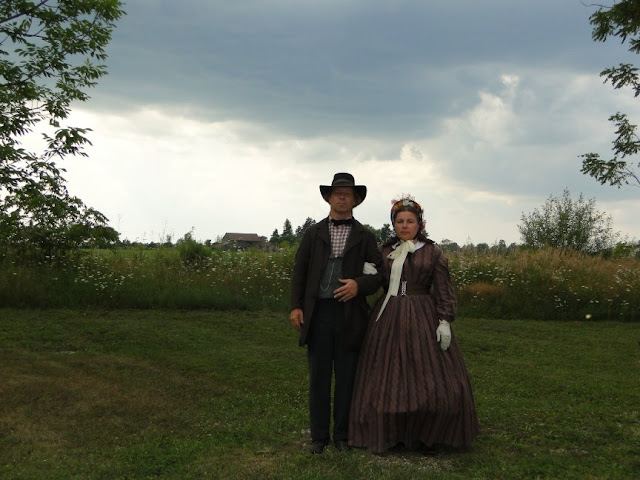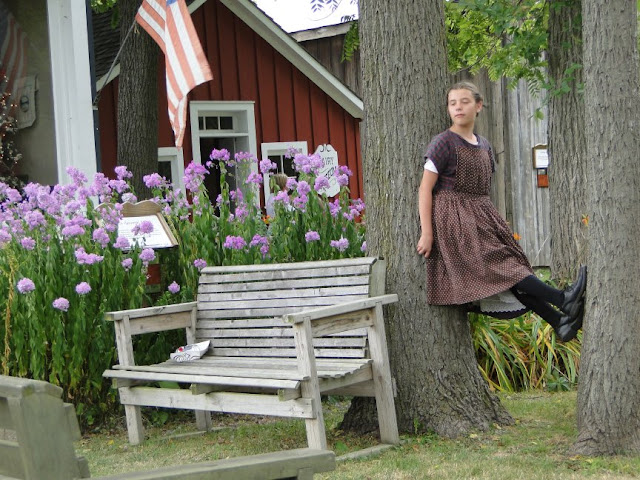
I know this post may sound like I'm angry. I'm really not. Just a bit frustrated.
As you may know, I take living history quite literally and quite seriously. I enjoy making the attempt to be as accurate as my knowledge of the early 1860's will allow. I try to teach the truth in a non-discriminate way - as much as I can, at least -
This school marm means business!when I am portraying one from the 19th century.
This year I have been able to take part in some of the most authentic reenactments that I believe have been portrayed, at least here in Michigan. I have been caught, as a civilian, in the middle of a battle, having to run from my home to safety. I have also participated in a homecoming - and then a send off - of Union soldiers.
Even a real period wedding (my own renewal of the vows!) and ball.
And in past years I have played a role in medical treatments and in mourning practices of the 19th century. I have seen folks so "into" this living history that real tears roll down their cheeks at the 'death' of their loved one.
I must say, the greater majority of this authenticity comes from the civilian reenactors/living historians.
It's true.
The military pretty much have it all laid out for them: they can purchase complete uniforms with all of the accouterments at nearly any sutler or hundreds of shops on line. They have numerous drills to learn how to march in formation. As for their muskets they go through drill after drill to learn how to use them safely and properly.
But, it all seems to end there. Most do or know little to nothing when it comes to period camp life, dying in battles, or speaking to the public. Rarely do I see grim looking soldiers marching off to the battlefield. Instead, they're laughing and joking - sometimes even during a battle. I have photographs as proof! Rarely do I see a soldier praying or reading his bible while in camp, or writing a letter home to loved ones (which he could read to patrons who visit the camp). That happened frequently but reenactors rarely show that side of a soldier's life. Rarely do I see soldiers die in a grimace - in pain - when "hit" with a bullet. Instead, they carefully move to one knee, then the other, then carefully move the rest of their body to the ground, mindful of not dirtying their uniform, only to then sit up on their elbows to watch the rest of the battle. Or maybe even to speak with another 'wounded' comrade next to him. Oh yes. This I have seen repeatedy by nearly every soldier that takes a hit. And the audience sees this and laughs, points, and makes those soldiers look like fools. I can only think of once or twice hearing a soldier cry out in pain after he had been "shot".
And, don't even get me going on the ever-present musket crutch!
 This Reb died a good death!
This Reb died a good death!I have never seen an 'after battle' scenario where the civilian 'townsfolk' go out onto the battlefield to search for the dead and wounded, finding the living among the dead, writhing in pain, and help them to a hospital tent, or to their 'home' (civilian tent) to be used as a hospital, just like the folks in the 1860's took the wounded into
their homes.
There was so much more to this war and its battles that we can present. Instead we seem to cater to the PC crowd and decidedly sugarcoat the horrors for both soldier
and civilian.
The following is taken from the book
The Lincolns - A Scrapbook Look at Abraham and Mary by Candace Fleming. It's a terrific light biography of our 16th president & his wife and it includes loads of photographs, documents, and many unusual bits of facts and information that I wasn't aware of.
This particular piece I have included here captures the thought process of so many at the beginning of the Civil War:On a scorching hot Sunday in July 1861, 30,000 Union troops under the command of Irwin McDowell marched south toward Manassas, Virginia. With them came six U.S. senators, ten members of the House of Representatives, scores of newspaper reporters, and dozens of ladies with picnic baskets and opera glasses. Bursting with self-confidence, Northerners thought defeating the South would be a simple matter of attacking at Manassas, then moving on to take the Confederate capital of Richmond, Virginia, just sixty miles away. They sincerely believed this would be the one and only battle of the war, so they camped on a nearby hillside, nibbling on cold chicken and waiting for the action to begin. Back in Washington, Lincoln waited, too. With members of his cabinet, he listened to the early reports. They were confusing. The two armies had met at a meandering creek called Bull Run. Each had advanced and retreated, advanced and retreated. It wasn't until six o'clock in the evening that Lincoln heard the news: the Union army had crumbled. Panic-stricken soldiers had fled back to Washington, only to find the roads blocked by terrified sightseers. People had pushed and shoved. Screams had filled the smoke-thick air. Artillery shells had rained down. And, when it was over, five thousand people lay dead. As dawn broke, Lincoln watched from a White House window while mud-splattered, blood-streaked troops limped back into the capital through a dismal rain...And this from Bruce Catton's American Heritage New History of the Civil War of the very same battle:Hundreds of Washingtonians had come out to see the show that day. They came in carriages, wagons, buggies, and on horseback, they brought hampers of food and drink with them, and they were spread all over the slanting fields east of Bull Run, listening to the clangor of the guns, watching the smoke clouds billowing up to the July sky, and in general making a holiday out of it.
 This battle is quite nice, isn't it?
This battle is quite nice, isn't it?
Now, as Union wagon trains, ambulances, reserve artillery, and knots of disorganized stragglers began to take the road back to Washington, all of these civilians decided that it was high time for them to get out of there. They got into their conveyances and went swarming out onto the highway which the army wanted to use, creating the father and mother of all traffic jams; and just as things were at their worst, a stray Confederate shell came arching over and upset a wagon on a bridge over a little stream called Cub Run, blocking the road completely.And, from the same book, a 1st person account from London Times reporter William H. Russell:My attention was called to a tumult in front of me at a small bridge across the road, and then I perceived the drivers of a set of wagons with the horses turned towards me, who were endeavoring to force their way against a stream of vehicles setting in the other direction. At the bridge the currents met in wild disorder. "Turn back! Retreat!" shouted the men from the front. "We're whipped! We're whipped!" Soon I met soldiers who were coming through the corn, mostly without arms...the ambulances were crowded with soldiers...men literally screamed with rage and fright when their way was blocked up. Faces black and dusty, tongues out in the heat, eyes staring----Back to Mr. Catton's description:There was unadulterated turmoil, growing worse every moment, with disorganized troops and panicky civilians trying to force their way through a horrible tangle of wheeled vehicles, mounted men riding around, and past them bodies of troops trying in vain to march where they had been told to march; a new surge of fear rising every now and then when someone would shout that the Confederate cavalry was coming on the scene. In the dust and confusion of this disorganized retreat, frightened individuals began to shout that the black horse cavalry was upon them, and outright panic developed, with bewhildered thousands dropping their weapons and starting to run, communicating their fears to others by the simple act of running. Before dark there was complete and unregimented chaos spilling all over the landscape, and hardly anyone who could move at all stopped moving until he had reached the Potomac River. The federals had lost 2, 896 men in killed, wounded, and missing, and Confederate losses came to 1,982. People began to see that beneath the romance which had been glimpsed in the bright uniforms, the gay flags, and the lilting tunes played by the military bands, there would be a deep and lasting grimness. Holiday time was over.This just brings it all home, doesn't it?
I continue to find this particular part of the War fascinating. To think that people actually sat down to a picnic to watch soldiers fight a battle - no matter that this would supposedly be a quick and easy war.
Just like at a reenactment.
Except, after the reenactment, the (ugghh!) announcer will then say something silly like "Now, will all the dead soldiers become resurrected!" And the audience laughs and claps as the fallen soldiers miraculously rise from the dead (unless the 'dead' are in a deep conversation with another dead soldier and doesn't pay attention.
We need to show more of the way it really was, like in the above accounts.
 At the Crossroads event, all participants practiced 1st person - soldier and civilian. A younger sister gives a farewell hug to her older brother as he prepares to leave for war. Both siblings here are two of my four kids. Both get into 1st person pretty heavily.
At the Crossroads event, all participants practiced 1st person - soldier and civilian. A younger sister gives a farewell hug to her older brother as he prepares to leave for war. Both siblings here are two of my four kids. Both get into 1st person pretty heavily.I hope that, even with all the fun I have while doing living history as I show everyday life of a civilian, that I can also convey to the visitor the madness and sorrow the Civil War brought to thousands upon thousands on both sides.
I am nowhere near perfect, of course, in my living history endeavors, and I hope my writing doesn't convey that message. But, I try. I guess because the civilians that I reenact with truly make the attempt to bring the past to life as accurately as they can, I would expect to see soldiers do the same.
Or am I asking too much?
.



 Some excerpts from the ad above: It says- “this young man is 11 months old- and he isn’t our youngest customer by any means. For 7-Up is so pure, so wholesome, you can even give it to babies and feel good about it. -By the way, Mom, when it comes to toddlers- if they like to be coaxed to drink their milk, try this: Add 7-Up to the milk in equal parts, pouring the 7-Up gently into the milk. It’s a wholesome combination- and it works! Now we know the origins of ADHD......
Some excerpts from the ad above: It says- “this young man is 11 months old- and he isn’t our youngest customer by any means. For 7-Up is so pure, so wholesome, you can even give it to babies and feel good about it. -By the way, Mom, when it comes to toddlers- if they like to be coaxed to drink their milk, try this: Add 7-Up to the milk in equal parts, pouring the 7-Up gently into the milk. It’s a wholesome combination- and it works! Now we know the origins of ADHD......

























